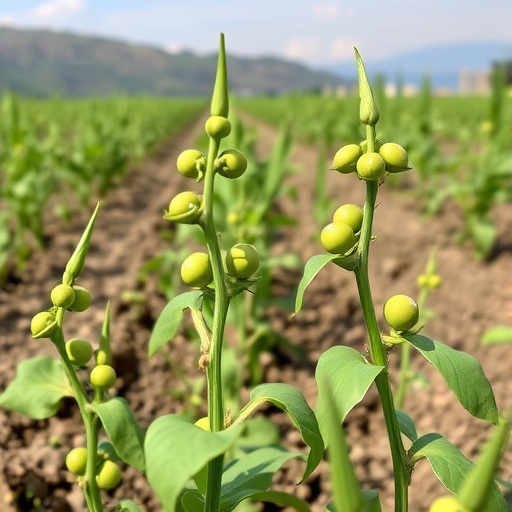In a captivating exploration of plant-microbe interactions, recent research has unveiled significant findings regarding the isolation and biochemical characterization of indigenous rhizobia from the root nodules of field pea (Pisum sativum L.). Conducted by Haftu, Abera, and Kasegn, this study sheds light on the potential of these native microorganisms as bio-inoculants to enhance the growth of the Bursa variety in the Tigray region of Ethiopia. The implications of these findings could revolutionize agricultural practices in the region.
The study addressed a critical question: How can local agriculture benefit from the natural symbiotic relationships between legumes and rhizobia? The researchers embarked on an ambitious quest to isolate and characterize the rhizobia indigenous to the Tigray region. This endeavor not only aimed to fill knowledge gaps regarding the local microbiome but also to assess how these organisms could contribute to boosting crop yields.
Field peas are a significant crop for food security and sustainable agriculture, especially in regions with challenging soil conditions. The researchers emphasized that understanding the indigenous rhizobia is key to improving the agricultural productivity of legumes. By isolating these bacteria from root nodules, they aimed to tap into their potential to fix atmospheric nitrogen, a crucial process that enhances soil fertility and plant growth.
The team employed stringent biochemical methods to characterize the isolated rhizobia, employing techniques that revealed their metabolic capabilities and interactions with host plants. These analyses provided insights into the diversity of rhizobia present in the root nodules and their functional attributes, which can directly influence agricultural practices. The study highlighted how variations in biochemical characteristics among the isolated strains could lead to different levels of effectiveness as bio-inoculants.
Following the isolation and characterization of the indigenous rhizobia, the researchers turned their attention to evaluating the bio-inoculant potential of these microorganisms on the Bursa variety of field pea. This evaluation involved meticulously designed experiments to monitor plant growth metrics, including root nodulation, shoot height, and overall biomass production. Such holistic assessments are crucial in determining the practical applicability of these bio-inoculants in field conditions.
Beyond the immediate benefits to the crop, the findings of this research could lead to long-term sustainability in agriculture. The utilization of native rhizobia can reduce the dependency on chemical fertilizers, thereby minimizing environmental impacts and promoting healthier farming practices. The researchers argued that these indigenous microorganisms offer a promising avenue for enhancing soil health and promoting sustainable agricultural practices in Tigray and beyond.
As agricultural challenges continue to escalate due to climate change and increasing population demands, the quest for sustainable solutions has never been more urgent. This study stands out as it not only contributes to academic knowledge but also offers practical solutions to real-world farming issues. The potential for these bio-inoculants has piqued interest across the agricultural community, opening doors for future research and collaboration.
In conclusion, Haftu, Abera, and Kasegn’s groundbreaking work illustrates the significance of indigenous rhizobia in enhancing the productivity of field peas in Tigray, Ethiopia. By combining rigorous scientific methodology with a focus on local ecosystems, this research exemplifies how traditional agricultural knowledge can inform modern practices. The authors hope their findings inspire further investigations into the potential of native microorganisms, encouraging farmers to adopt bio-inoculants as a viable solution for sustainable agriculture.
The study undoubtedly sets a precedent for future research in the field of agricultural microbiology, emphasizing the critical role of soil health and biodiversity in crop production. Given the preliminary success observed in the growth of the Bursa variety, further exploration into different crops and regions could yield transformative results for global agriculture.
As the agricultural landscape increasingly embraces the intersection of science and sustainability, the contributions from this research could provide a vital blueprint for integrating ecological principles into conventional farming practices. The quest for resilient agricultural systems continues, but the insights gained from these indigenous rhizobia stand as a beacon of hope for farmers seeking innovative solutions to age-old challenges.
In the coming years, the researchers envision scaling up their findings through partnerships with local farmers and agricultural institutions, fostering a community-oriented approach to bio-inoculant application. Such collaborations are essential for ensuring that scientific advancements translate into practical benefits for those who need them most.
Haftu, Abera, and Kasegn’s study not only enriches our understanding of plant-microbe interactions but also invites a larger conversation about the importance of local biodiversity in sustainable agriculture. The implications of their research extend far beyond Tigray, as similar strategies could be adopted globally, heralding a new era of environmentally friendly farming practices that honor the symbiotic relationships present in nature.
As this riveting research garners attention, the excitement surrounding the potential of indigenous rhizobia serves as a reminder of the untapped resources found within our ecosystems. The journey of discovery is far from over, and with each new study, the agricultural community takes one more step toward a sustainable future.
Subject of Research: Isolation and biochemical characterization of indigenous rhizobia from root nodules of field pea (Pisum sativum L.) and their potential as bio-inoculants.
Article Title: Isolation and biochemical characterization of Indigenous rhizobia from root nodules of field pea (Pisum sativum L.) and assessment of their bio-inoculants potential on the growth of Bursa variety in Tigray, Ethiopia.
Article References:
Haftu, S.Z., Abera, H.K., Kasegn, M.M. et al. Isolation and biochemical characterization of Indigenous rhizobia from root nodules of field pea (Pisum sativum L.) and assessment of their bio-inoculants potential on the growth of Bursa variety in Tigray, Ethiopia.
Discov Agric 3, 234 (2025). https://doi.org/10.1007/s44279-025-00416-z
Image Credits: AI Generated
DOI: https://doi.org/10.1007/s44279-025-00416-z
Keywords: Indigenous rhizobia, field pea, bio-inoculants, sustainable agriculture, Tigray, nitrogen fixation, plant-microbe interactions, ecological practices.




